공지사항
-
- '노란봉투'캠페인/국제연대..
- no chr.!

Oct. 22, Ssangyong Memorial Site nearby Daehanmun, the main entrance of Deoksu-gung(palace) in the center of Seoul: Kim Jeong-woo, head of the Ssangyong chapter of the Korean Metal Workers' Union, since two weeks in hunger strike to emphasize the demand of the dismissed Ssangyong workers for reemployment, promised 3 years ago...
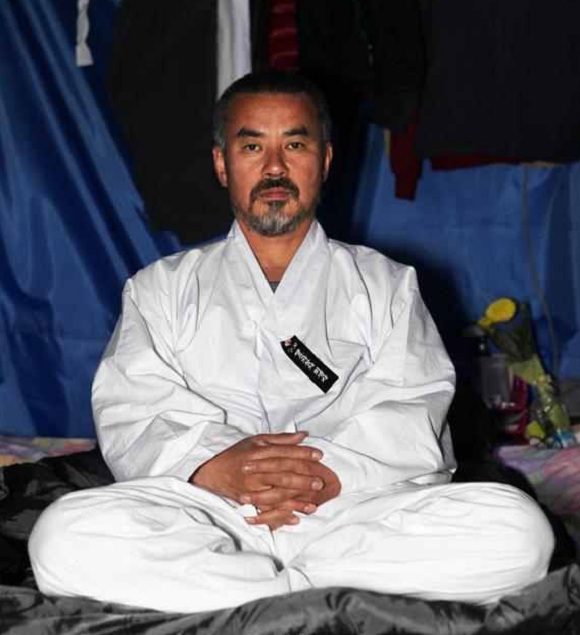
(source of the pic: 'Jombbae Jum')
Five days ago(10.17) comrade Jeong-woo was visited by Kim Jin-suk of the Korean Confederation of Trade Unions(January 2011, comrade Jin-suk launched a 309-day protest on a crane at Hanjin Heavy & Industries shipyard in Busan)...
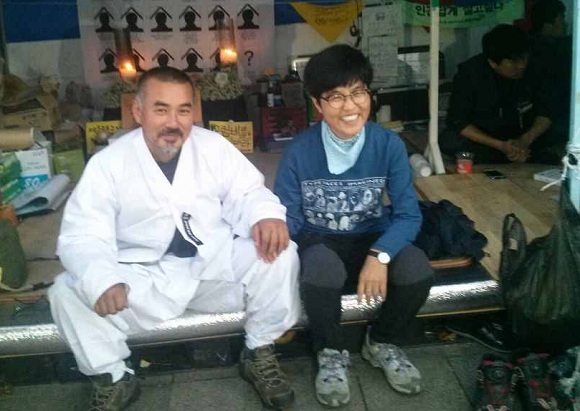
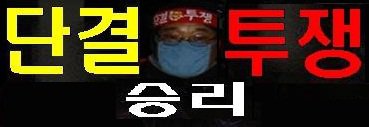

Solidarity with the Protest of Hyundai Workers in Ulsan!
As the sit-in struggle on top of a steel pylon in Ulsan...
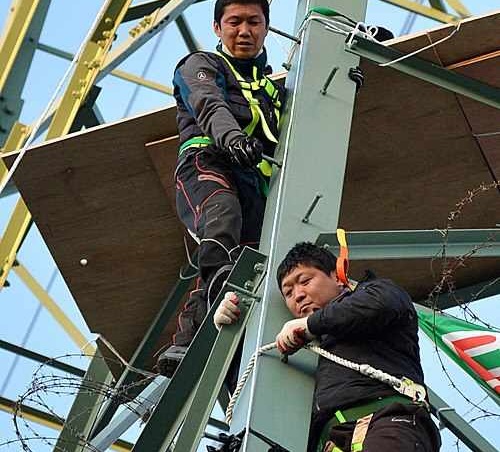
...by in-house subcontractor employees of Hyundai Motor entered the fourth day on Oct. 20, more and more groups have stepped forward to stand in solidarity with the strikers and expressed support...
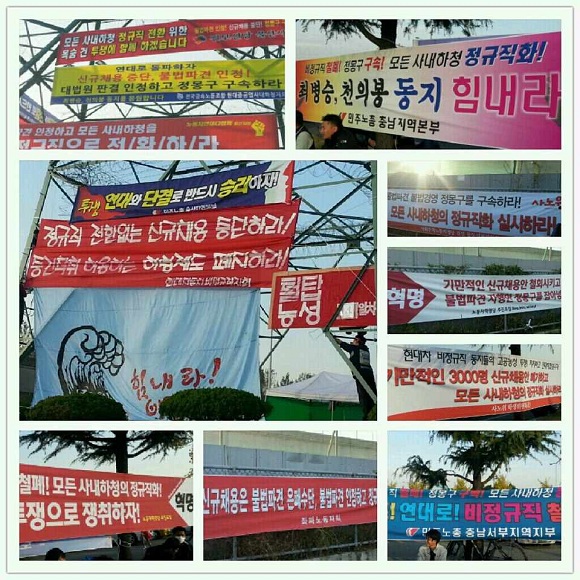
...for their action(*)

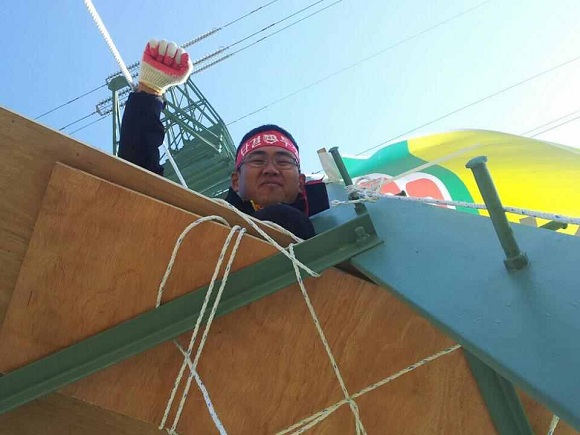
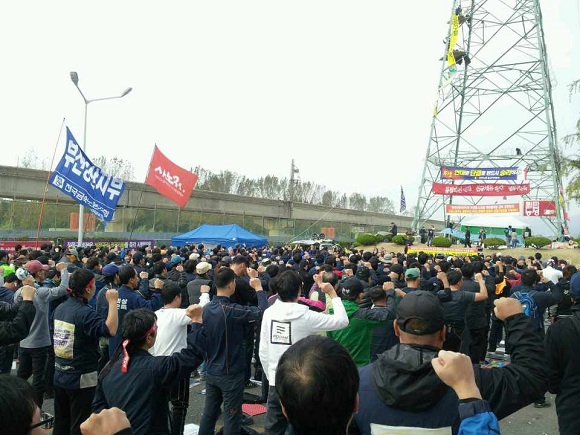
* Related reports:
☞ Ulsan labor protest making a splash (Hankyoreh, 10.20)
☞ 20일 울산 고공농성 사수 결의대회 (CCmedia, 10.19)
☞ “모든 사내하청 정규직 전환해야” (NewsCham, 10.19)
☞ 현대차 비정규직 2명 울산공장 철탑 고공농성 (KCTU, 10.18)

Solidarity with the Protest of Hyundai Workers in Ulsan!
The protest began at around 10:30 pm on Oct. 17 when Choe Byeong-seung and Cheon Ui-bong ascended a 50-meter electrical pylon near the Myeongchon Gate of Hyundai Motor’s factory in Ulsan. Choe, 36, was previously dismissed from his position as an in-house subcontractor employee at Hyundai Motor. Cheon, 31, is secretary-general of the temporary worker union’s Hyundai Motor chapter. By staging protest, workers hope to finally resolve illegal dispatch worker issue. Here you can read a detailed article, published in today's Hankyoreh!
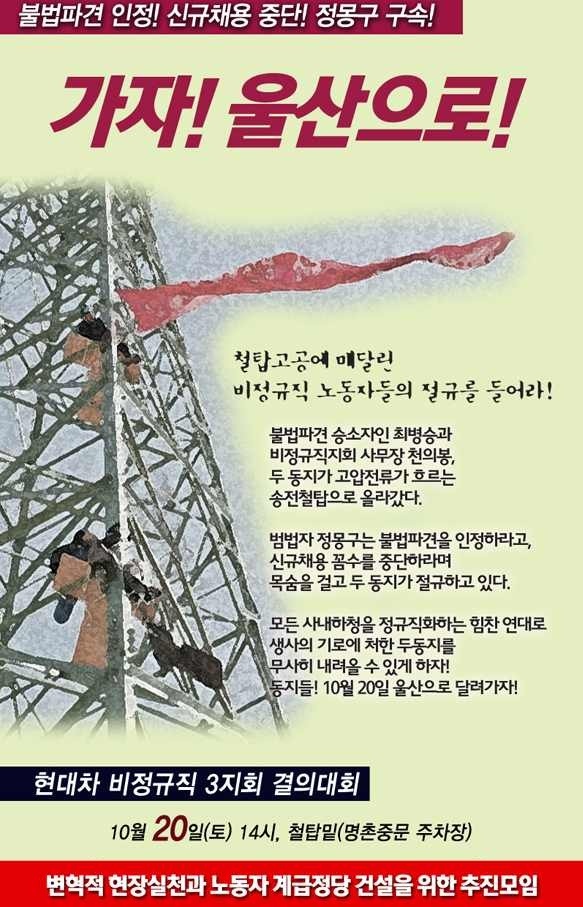
Two labor activists - one official of the irregular workers' union of Hyundai Motors and the other a former irregular worker at the automaker - are now in sit-in strike on a power supply post at the company's plant in the southeastern city of Ulsan to demand Hyundai give its irregular workers permanent stable employment contracts. Last night they climbed up the 50 meter post and tied themselves to it, with one at a 10 meter height and the other at 25 meters...

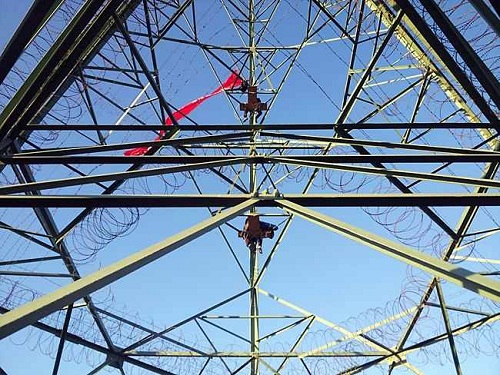
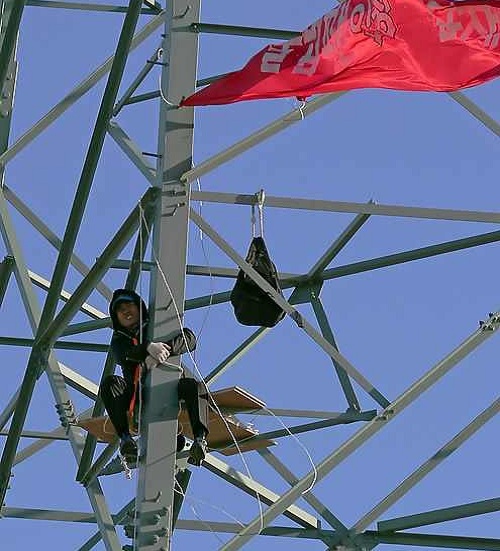

Related articles:
☞ 현대차 비정규직 2명 울산 송전탑 고공농성 (NewsCham, 10.18)
☞ "모든 사내하청 정규직 전환, 꼭 쟁취합시다" (iLabor, 10.18)
☞ 현대차 비정규직 노동자들, 고공농성 돌입 (VOP, 10.18)


12 days ago - under the motto "All is the Sky, We are the Sky" - the "Grand March for Life & Peace"(more detailed info you'll find here) started in Jeju City...
Last station (y'day, 10.16) was in Daegu. Impressions from the culture festival in the center of the city(*):


Next stop will be tomorrow in Jeonju...


* More pics you can see here(Ulsan, 10.14) and here(Gumi, 10.15)! And finally here you can watch the latest video report.

Let's abolish the notorious "National Security Law"!
Impressions from some (sort of) clandestine resistance in Seoul against the (f*cking) "Nat'l Intelligence Service"(NIS/국가정보원):
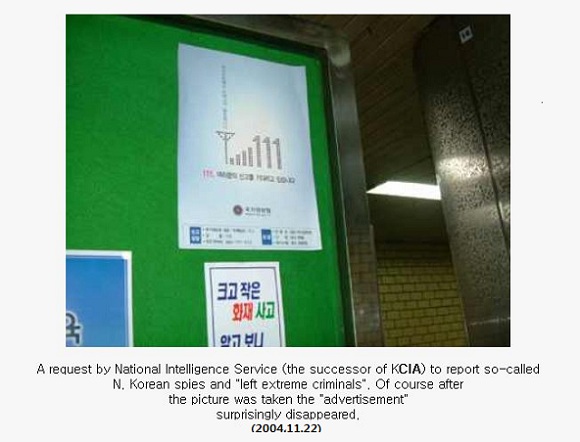
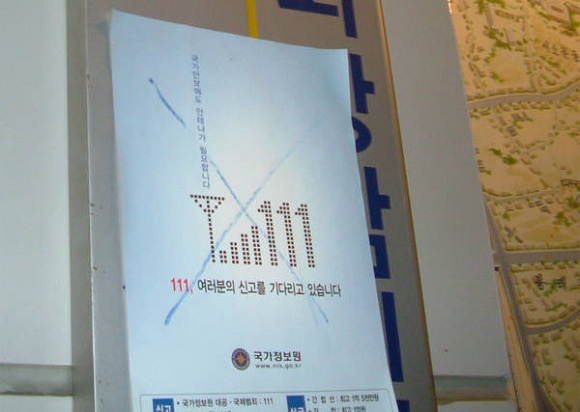
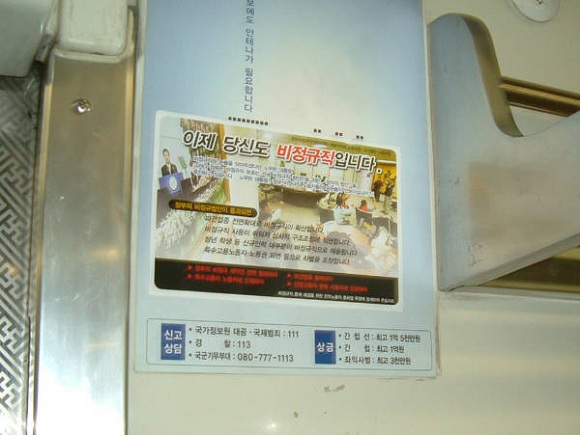


Oct. 14, Ssangyong Memorial Site nearby Daehanmun, the main entrance of Deoksu-gung(palace) in the center of Seoul: Kim Jeong-woo, head of the Ssangyong chapter of the Korean Metal Workers' Union, since 5 days in hunger strike to emphasize the demand of the dismissed Ssangyong workers for reemployment, promised 3 years ago

Related articles:
☞ 쌍용차 비상시국회의 개최...김정우 지부장 단식 돌입 (NewsCham, 10.10)
☞ "유서를 읽겠습니다" - 쌍용차 김정우 지부장 단식 돌입 (Redian, 10.10)
☞ 23번째 희생에 쌍용차 지부장, 단식투쟁 돌입... (VOP, 10.10)

Although the following - possibly very controversial(^^) - text, written by Chr. Hitchens, is already two years old... but (IMO) it's still worth reading!!
A Nation of Racist Dwarfs
Kim Jong-il's regime is even weirder and more despicable than you thought
Visiting North Korea some years ago, I was lucky to have a fairly genial "minder" whom I'll call Mr. Chae. He guided me patiently around the ruined and starving country, explaining things away by means of a sort of denial mechanism and never seeming to lose interest in the gargantuan monuments to the world's most hysterical and operatic leader-cult. One evening, as we tried to dine on some gristly bits of duck, he mentioned yet another reason why the day should not long be postponed when the whole peninsula was united under the beaming rule of the Dear Leader. The people of South Korea, he pointed out, were becoming mongrelized. They wedded foreigners—even black American soldiers, or so he'd heard to his evident disgust—and were losing their purity and distinction. Not for Mr. Chae the charm of the ethnic mosaic, but rather a rigid and unpolluted uniformity.
I was struck at the time by how matter-of-factly he said this, as if he took it for granted that I would find it uncontroversial. And I did briefly wonder whether this form of totalitarianism, too (because nothing is more "total" than racist nationalism), was part of the pitch made to its subjects by the North Korean state. But I was preoccupied, as are most of the country's few visitors, by the more imposing and exotic forms of totalitarianism on offer: by the giant mausoleums and parades that seemed to fuse classical Stalinism with a contorted form of the deferential, patriarchal Confucian ethos.
Karl Marx in his Eighteenth Brumaire wrote that those trying to master a new language always begin by translating it back into the tongue they already know. And I was limiting myself (and ill-serving my readers) in using the pre-existing imagery of Stalinism and Eastern deference. I have recently donned the bifocals provided by B.R. Myers in his electrifying new book The Cleanest Race: How North Koreans See Themselves and Why It Matters, and I understand now that I got the picture either upside down or inside out. The whole idea of communism is dead in North Korea, and its most recent "Constitution," "ratified" last April, has dropped all mention of the word. The analogies to Confucianism are glib, and such parallels with it as can be drawn are intended by the regime only for the consumption of outsiders. Myers makes a persuasive case that we should instead regard the Kim Jong-il system as a phenomenon of the very extreme and pathological right. It is based on totalitarian "military first" mobilization, is maintained by slave labor, and instills an ideology of the most unapologetic racism and xenophobia.
These conclusions of his, in a finely argued and brilliantly written book, carry the worrisome implication that the propaganda of the regime may actually mean exactly what it says, which in turn would mean that peace and disarmament negotiations with it are a waste of time—and perhaps a dangerous waste at that.
Consider: Even in the days of communism, there were reports from Eastern Bloc and Cuban diplomats about the paranoid character of the system (which had no concept of deterrence and told its own people that it had signed the Non-Proliferation Treaty in bad faith) and also about its intense hatred of foreigners. A black Cuban diplomat was almost lynched when he tried to show his family the sights of Pyongyang. North Korean women who return pregnant from China—the regime's main ally and protector—are forced to submit to abortions. Wall posters and banners depicting all Japanese as barbarians are only equaled by the ways in which Americans are caricatured as hook-nosed monsters. (The illustrations in this book are an education in themselves.) The United States and its partners make up in aid for the huge shortfall in North Korea's food production, but there is not a hint of acknowledgement of this by the authorities, who tell their captive subjects that the bags of grain stenciled with the Stars and Stripes are tribute paid by a frightened America to the Dear Leader.
Myers also points out that many of the slogans employed and displayed by the North Korean state are borrowed directly—this really does count as some kind of irony—from the kamikaze ideology of Japanese imperialism. Every child is told every day of the wonderful possibility of death by immolation in the service of the motherland and taught not to fear the idea of war, not even a nuclear one.
The regime cannot rule by terror alone, and now all it has left is its race-based military ideology. Small wonder that each "negotiation" with it is more humiliating than the previous one. As Myers points out, we cannot expect it to bargain away its very raison d'etre.
All of us who scrutinize North Korean affairs are preoccupied with one question. Do these slaves really love their chains? The conundrum has several obscene corollaries. The people of that tiny and nightmarish state are not, of course, allowed to make comparisons with the lives of others, and if they complain or offend, they are shunted off to camps that—to judge by the standard of care and nutrition in the "wider" society—must be a living hell excusable only by the brevity of its duration. But race arrogance and nationalist hysteria are powerful cements for the most odious systems, as Europeans and Americans have good reason to remember. Even in South Korea there are those who feel the Kim Jong-il regime, under which they themselves could not live for a single day, to be somehow more "authentically" Korean.
Here are the two most shattering facts about North Korea. First, when viewed by satellite photography at night, it is an area of unrelieved darkness. Barely a scintilla of light is visible even in the capital city. (See this famous photograph.) Second, a North Korean is on average six inches shorter than a South Korean. You may care to imagine how much surplus value has been wrung out of such a slave, and for how long, in order to feed and sustain the militarized crime family that completely owns both the country and its people.
But this is what proves Myers right. Unlike previous racist dictatorships, the North Korean one has actually succeeded in producing a sort of new species. Starving and stunted dwarves, living in the dark, kept in perpetual ignorance and fear, brainwashed into the hatred of others, regimented and coerced and inculcated with a death cult: This horror show is in our future, and is so ghastly that our own darling leaders dare not face it and can only peep through their fingers at what is coming.
"WE ARE NOT SLAVES!"
Migrant workers in S. Korea are still fighting for human and labor rights! Impressions, photographed(9.23 in Seoul) by comrade Soe Moe Thu:
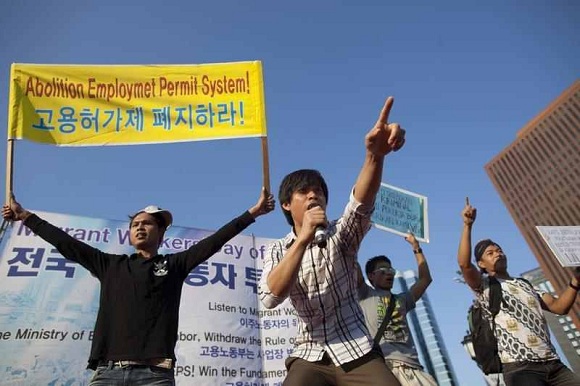
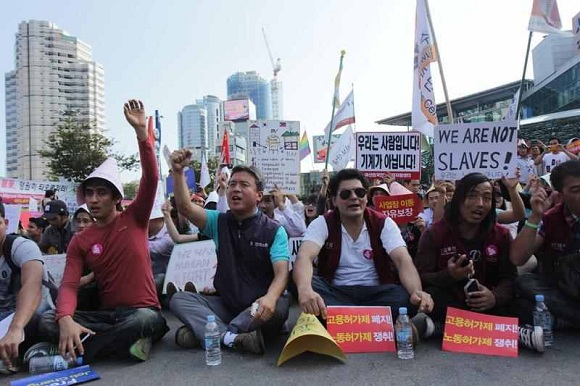
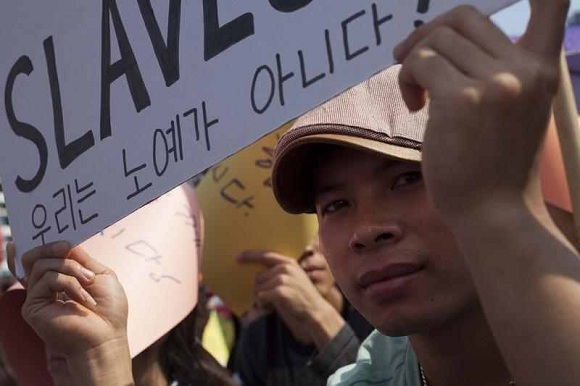
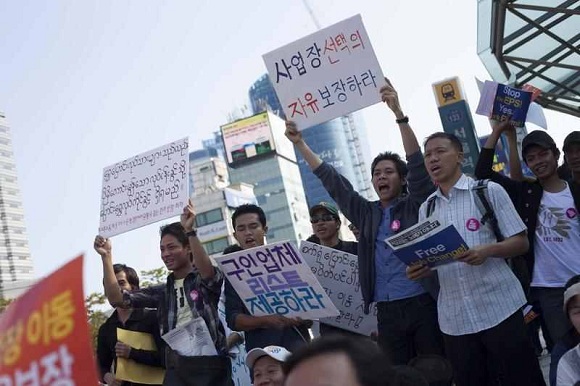

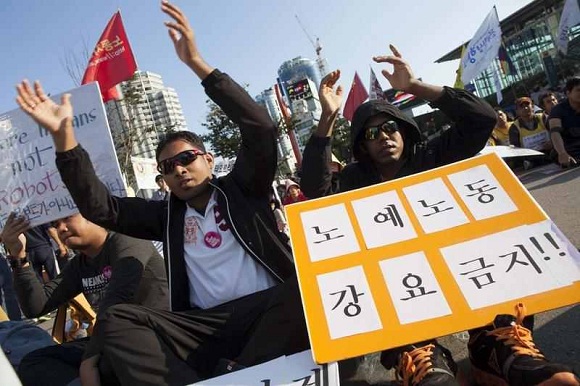


Related contribution:
☞ [9.23] 'Migrant Workers Day of Struggle'
최근 덧글 목록